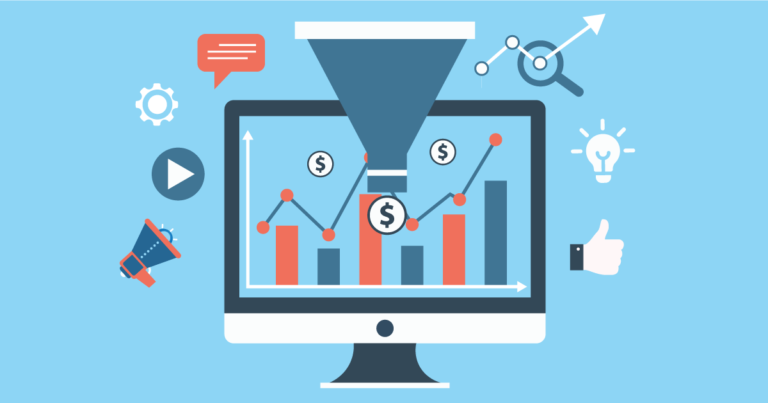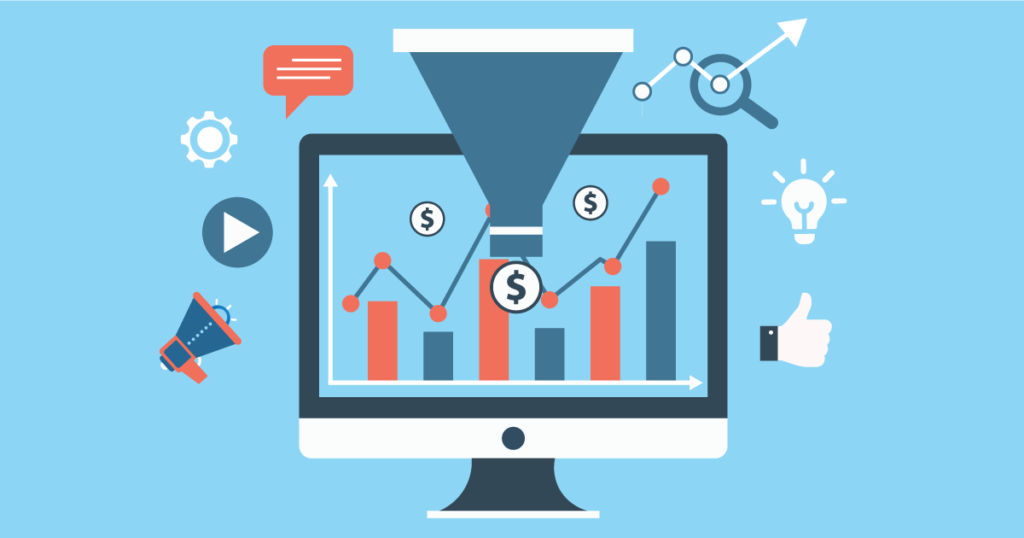Sales Funnel Metrics: The Complete Guide to Key Metrics

Have you set up a sales funnel for your business and are trying to understand the various sales funnel metrics you should be tracking?
The sales funnel is a graphical depiction of the customer journey that depicts the marketing strategy from knowledge to execution.
Often referred to as a marketing funnel or revenue funnel, it illustrates that while many potential customers may enter at the top, only a small fraction ultimately make a purchase.
A sales funnel is a customer’s purchasing process at its most basic.
It’s a method of measuring the user journey – from when a person discovers a company brand, engages with them, learns more about the company’s products, and, hopefully, makes a purchase.
However, a sales funnel isn’t only about the consumer; it’s also about the company.
Sales funnels may be applied to almost any company in any sector.
The shape of that funnel varies depending on the company’s items and procedure of services.
For example, if a company is selling enterprise software, it may have a much longer sales funnel with several meetings and discussions. In contrast, a business selling cosmetic products may have a very short funnel with only a few interactions.
Awareness, interest, desire, and action are the four stages of the sales funnel. The aim at each level is to proactively assist the consumer in progressing to another level of the process unless they shift.
So, with all that in mind, what are the various sales funnel metrics you should know about? Which ones are most important to track?
Read on for all this info and much more…
Table of Contents
Understanding the Sales Funnel
Before we discuss sales funnel metrics, let’s talk a little more about what a good sales funnel does:
- Brings in new customers – The goal of a sales funnel is to take a company’s target audience and guide them through a sequence of stages that will hopefully lead to them becoming clients.
- Referrals are generated – A sales funnel acquires a primary target audience and set of customers and encourages pleased customers to refer new prospects who may not have previously fit into the initial target population.
- Tracks and monitors – A sales funnel allows businesses to monitor how effectively each phase of the selling process functions and make changes as needed. It implies that time and sales requirements are met. Moving consumers further around the sales funnel generates valuable feedback.
- Concentrates efforts – A sales funnel directs a company’s attention to a particular set of clients. When people come to the end of the funnel, it becomes easy to reach out to them and set them as the target audience. A sales funnel may also assist companies in removing the prospects who are not so qualified. It happens when they compel potential consumers to run through phases that finally lead to a transaction.
The Sales Funnel In Action
The steps of the sales funnel will vary depending on the firm; however, they are commonly separated into four sections:
- Awareness – This is the stage with the most consumer potential. They’ve identified an issue, began looking for a solution, and become aware of a company through content marketing, an email campaign, social media marketing, or another channel.
- Interaction – The quantity of client prospects begins to decline at this point, but the likelihood of a sale conversion rises. It is usually when a customer contacts the company and asks for further information. In addition, the prospect will perform competitor research to see if the company’s product is an ideal fit for their needs.
- Interest – By contacting the company for solutions to their inquiries, the prospect increases interest in the company. This part of the procedure may involve sales offers, further research about the organization’s various possibilities, and price. If a consumer rejects to make a purchase, they are no longer progressing through the funnel.
- Action – The ultimate stage of the sales funnel is action, which brings together all of the preceding steps. The consumer has decided whether or not to buy the product at this stage. If the prospect decides not to buy, the company might utilize different marketing strategies to keep their product in front of their customers’ minds.
How To Create A Sales Funnel For The Company
To construct an effective sales funnel, a company should follow a few best practices. The following are some of them:
- Examine the audience’s actions – This entails identifying a target audience or the individuals who will be pulled to the funnel’s top. For a web-based firm, this can entail examining analytics on how visitors interact with the site, such as what individuals find most appealing and the bounce rate, which indicates how long they spend on the site’s pages.
- Attract the attention of the audience – There must be something that attracts them into the funnel in the first place. Rich material, such as infographics, films, and commercials, may be included.
- Direct the audience’s attention – Prospects require a destination after their attention has been captivated. For a web-based business, this entails creating a visually appealing landing page that collects data about the user’s experience and includes a call to action that encourages the prospect to participate.
- Produce leads – After the first three phases have been accomplished, it’s critical to keep generating fresh leads to add to the funnel. Salesforce, HubSpot, and Leadformly are a few lead-generating technologies firms may utilize to automate this process.
- Keep in touch with people – The most crucial step after generating and capturing leads, the most vital step is nurturing these prospects into clients. The goal of a sales funnel is to bring in new clients.
Advantages of Having a Sales Funnel
Productivity rises when each level of the sales funnel gives the company allowance to assess; the efficacy of the initiatives, and the productivity increases. There’s a benefit in the predictability of outcomes too. So people must take specific activities to progress through the sales funnel.
At the same time, they are entering personal details on a page in an ebook, for example. It results in the success of each stage is essential to the achievement of the preceding step, allowing you to track results.
The management enhancement of the funnel is used to segregate and simplify the sales funnel, allowing for an even more impartial and agile examination of each procedure step.
The sales funnel the method through which salespeople convert prospects into leads. One of the main goals in sales is to ensure the effectiveness of the sales funnel. After all, a successful sales funnel may give the sales team insight into prospects’ thinking processes, issues, and decisions. They are critical for automating the conversion of site traffic into clients.
Important Sales Funnel Metrics
There are many different sales funnel metrics that business owners should be tracking in order to measure the effectiveness of their marketing efforts. Some of the most important include lead generation, conversion rates, and customer lifetime value.
Entrances/Leads
Lead generation (or entrances) refers to the number of potential customers who have expressed interest in your products or services by filling out a contact form on your website or submitting their email address in exchange for a free download or discount.
Tracking this metric allows you to see which channels are performing well at bringing in new leads, and it can also help you identify any weaknesses or gaps in your marketing strategy.
Conversion Rate
Conversion rates track how many of these leads turn into actual paying customers.
This metric allows you to gauge the effectiveness of your sales approach and understand exactly where individuals are dropping off in the buyer’s journey from initial consideration to purchase.
“This can help you to improve your strategies to get more conversions,” Esther Straus, Co-founder of Step by Step Business said. “You can do so by experimenting with new sales tactics to see if your conversion percentage improves.”
For example, you might be able to increase your customer touchpoints during the sales process and see a bump in your percentage.
“But be aware, you might find that too many touches turn customers away and reduces your conversion percentage,” Strauss said. “By tracking this metric, you can find out what works and focus your efforts there.”
Total Sales
Another key metric to track is total sales. This metric gives you an overview of your entire sales funnel, revealing the amount of total sales generated over a period of time, such as a month or quarter.
By looking at this data over time, you can gain insights into how various components of your sales process are performing, helping you to optimize your efforts in order to generate even greater ROI.
Average Order Value
Average Order Value, or AOV, is a metric that measures the average amount that each customer spends per order. AOV is an important metric because it can help to assess the health of your business and identify areas for improvement.
For example, if you notice that your AOV is decreasing, it could be a sign that you need to focus on improving your product offerings or increasing your prices.
Alternatively, if your AOV is increasing, it could indicate that your marketing efforts are successfully driving up demand for your products. Either way, tracking your AOV can give you valuable insights into the health of your business.
Customer Lifetime Value
Finally, one of the most important sales funnel metrics is customer lifetime value, or CLV for short.
This metric measures how much revenue an individual customer will generate over time given their current relationship with your brand.
CLV is important because it helps you understand how much to invest in acquiring new customers and retaining existing ones. For example, if your CLV is very low, then it may not be worth investing too much in marketing to acquire new customers, since you will likely not recoup your investment over the course of that customer’s lifetime.
Final Thoughts on Sales Funnel Metrics
Whether you’re marketing online courses, selling informational products, or selling physical goods, having a well-optimized sales funnel can help your business thrive.
And remember, there are many different sales funnel metrics that business owners should be tracking in order to understand and optimize their marketing efforts.
By paying attention to these key metrics, you can improve the performance of your sales funnel and grow your business. And don’t forget, having a good sales funnel software can go a long way to helping you optimize your marketing efforts. Check out our guides to some of the most popular sales funnel builders at the links below:
Have any questions about understanding sales funnel metrics? Comment below and we’ll help you out.
Recent advancements in AI and data analytics are transforming how businesses track and optimise sales funnel metrics. Modern sales funnel tools now offer real‐time insights and predictive analytics that enable companies to personalise their marketing strategies and improve conversion rates continuously. By leveraging these emerging technologies, businesses can refine their funnels even further and maintain a competitive edge.
This post may contain affiliate links and we may earn commissions. Learn more in our disclosure.



